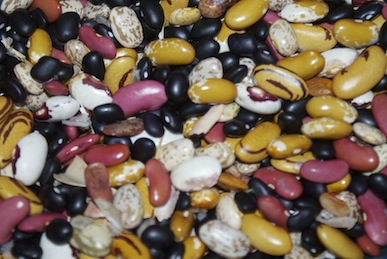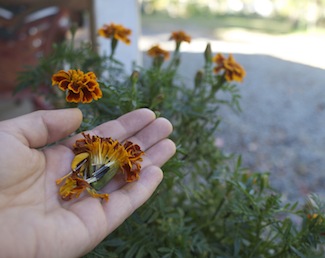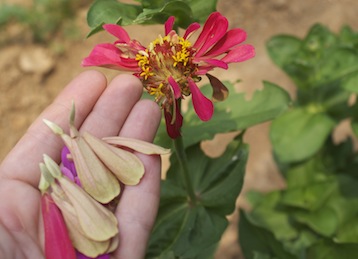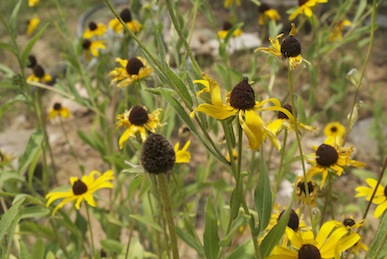One of Grateful Trees and Bees’ guiding principles goes like this: “Look around you for what’s required – life provides for necessity.” We certainly employ it in our tree services operations, choosing to see the wood debris generated by tree pruning or tree removal not as disposable waste, but rather as potential firewood, wood chips and mulch.
In truth though, we learned the necessity provision from the plants in our kitchen garden and yard. These miraculous green beings leave us the coolest gift each and every year: seeds. So take that Monsanto — we don’t need your seeds — Nature gave us ours for free!
In the hopes that we can make seed collectors of a few of our garden installation clients, here is the Grateful Trees and Bees Guide to the Easiest Six Seeds to Collect from your Kitchen Garden:
Soy, Green, Lima, Black, Jacob’s Cattle Gold, Tiger Eye, Maine Bumblebee, Red Kidney, Pinto, Calypso, Soldier, Kabouli Garbanzo — and the list could go on.
These are by far our favorite seeds to collect. It is a joy to run your fingers through a bowl of dried beans, their textures and vibrant colors those of jewels. Bean seeds are easy to collect. Simply let the beans dry on the plant in their pod: preferably in the garden, but if the deluge threatens, you can also hang them in a dry, humid and well ventilated location. Once dried, remove the seed pod from the plant and crack it open. Continue drying the seeds by spreading them out on newspaper or paper towels until they are hard enough to crack with a hammer. Then freeze the seeds in an airtight container for five days to kill the weevil eggs that may be under the seed coat. Allow the seeds to return to room temperature before opening the storage container.
Stripped French, Aztec, Single Stem
Around these parts, we tend to call these, respectively, little marigolds (those growing about 12″ tall), big marigolds (those growing 3′-4′ tall) and Tikki Torch (those growing 5′-6′ tall with single stems and orange petals like a daisy). For each of them, wait until their blooms die, then harvest the seed pod at the bloom’s base. The single stem Tikki Torch marigolds form a much harder seed pod that can really poke you, so I wear gloves for that seed harvest. Break open the seed pod to reveal the seeds. Store them in a glass jar and vent it often.
Will Rogers, Purple Prince, Lilliput, Peppermint Stick, Violet Queen, Creamy Yellow Giant, Sprite, Zin Master — and the list could go on.
This is the one flower we tend to harvest before it’s fully dried. Often harvesting from our favorite blooms just as they are starting to decay in the flower vase. This is because zinnias store a single seed at the end of each flower petal. Pluck the petal and you’ll harvest the seed. You can discard the petals that break off, but can also store the seeds with any attached petals, making sure to fully dry the petal and the seed. They make for a delicious aroma when you vent the glass seed jar.
This flower will do a great job of self seeding, but if you’d like to give it some serious legs and start a new patch way across your yard from an existing patch, the seeds are a cinch to gather. Wait for the blooms to die and you’ll see that the brown center of the bloom remains. Let it dry and then cut it off. Smush it in your fingers and you’ll see it disintegrate into tons of tiny brown seeds. Store in a paper envelope, or keep the seed balls whole and store them in a glass jar.
A wonderful and beautiful cover crop which we interplant with winter rye. It grows slowly throughout the winter and then in the spring bursts into a vibrant purple bloom. After blooming, seed pods form on the vines. Allow them to dry and then harvest the seeds within (small, black spheres) as you would dried beans.
This is a fabulous, self-propagating, quick cover-crop that goes from sowing to flowering in about forty-five days. And our bees LOVE the white flowers, though be careful if you go into a buckwheat field after noon. Buckwheat’s flowers shut down their nectar flow in the afternoon, which can really frustrate the bees. After flowering, the buckwheat will develop black seeds, each in a tiny brown casing, at the top of the stalks. Grasping the stalk in your hand and pull the seeds off and drop them into a cup or bucket. You can also cut down the buckwheat and place the entire plant where ever you want it to grow next. Or, simply leave the plant to decay where it stands. It will drop its seeds and you’ll have buckwheat growing there again soon.
If you don’t have these plants in your garden or yard yet, make the investment next spring in one packet of their seeds and we promise, you’ll never have to buy them again!
© 2014 Grateful Trees & Bees







